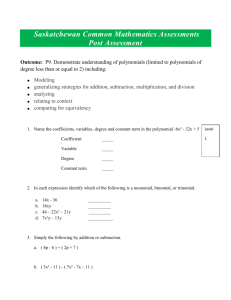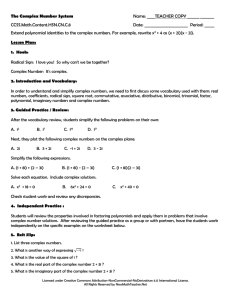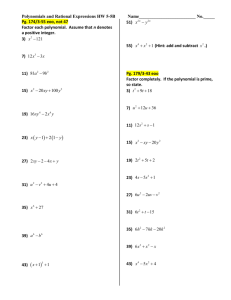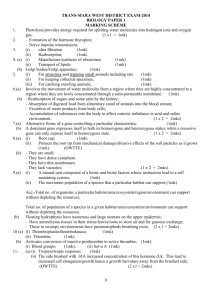P9.4 pre teacher aug12
advertisement
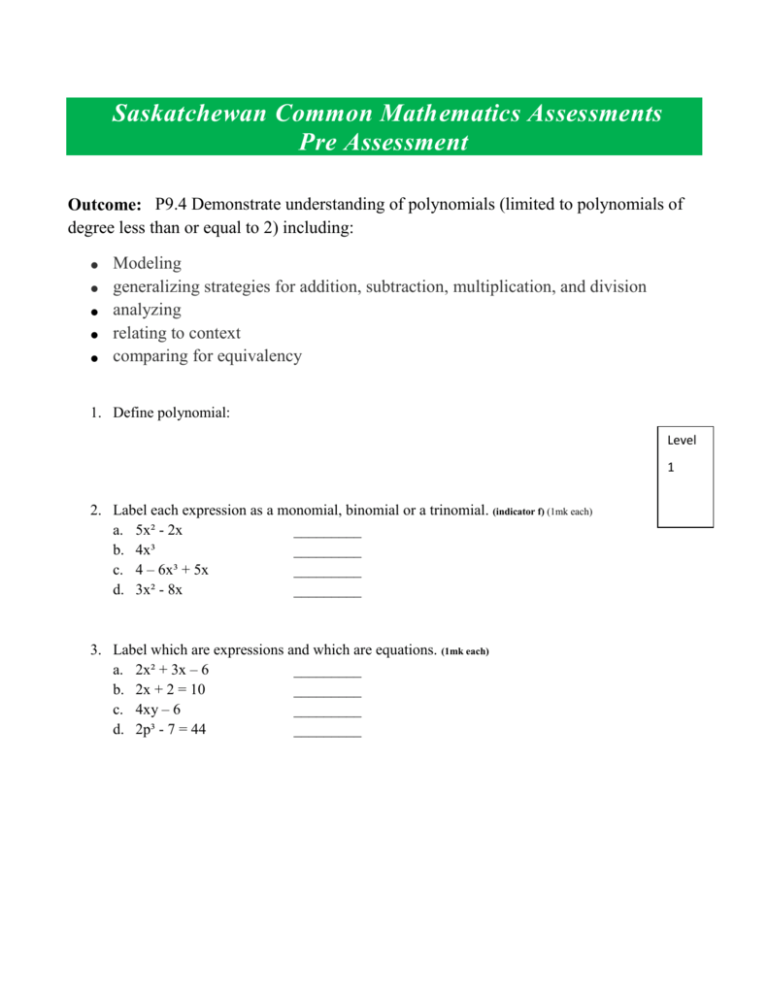
Saskatchewan Common Mathematics Assessments Pre Assessment Outcome: P9.4 Demonstrate understanding of polynomials (limited to polynomials of degree less than or equal to 2) including: Modeling generalizing strategies for addition, subtraction, multiplication, and division analyzing relating to context comparing for equivalency 1. Define polynomial: Level 1 2. Label each expression as a monomial, binomial or a trinomial. (indicator f) (1mk each) a. 5x² - 2x _________ b. 4x³ _________ c. 4 – 6x³ + 5x _________ d. 3x² - 8x _________ 3. Label which are expressions and which are equations. (1mk each) a. 2x² + 3x – 6 _________ b. 2x + 2 = 10 _________ c. 4xy – 6 _________ d. 2p³ - 7 = 44 _________ 4. A large white square represents an x² tile, a black rectangle represents a –x tile, and a small white represents a 1 tile. (Indicator b/c). (2mks) What polynomial does this collection represent? 5. Identify the degree of each polynomial? (Indicator d). (1mk each). a. 7t + 4 _________ b. 4 _________ c. 4p² -7 +6 _________ d. 13v _________ 6. Add or subtract the following as needed. a. 3x + 1 + 4x – 2 b. -y² + 7y – 5 - (2y² + 7y – 4) (Indicator J). (1mk each) Level 2 7. Multiply or divide the following. (Indicator M). (1mk each) a. 5x · 3y = b. 6x ( x + 1 ) = c. 6x = 3 d. 25xy ÷ 5xy = 8. Keith does not understand how the terms 2𝑘 𝑎𝑛𝑑 𝑘 2 are different. Use algebra tiles to model these terms and explain the difference. 9. The polynomial 54𝑠 2 represents the surface area of a cube. Determine a polynomial that represents the area of one face. Level 3 10. Use your answer from question 8. Determine the length of an edge of the cube. 11. Martin is placing square ceramic tiles on his rectangular kitchen floor. He uses a total of 180 square tiles. The length is 8 tiles longer than the width. If the floor is x tiles wide, which equation would represent the area of Martin’s kitchen? a. b. c. d. x2 + 8x −180 = 0 x2 + 8x +180 = 0 8x2 −180 = 0 8x2 +180 = 0 Draw a diagram to help you explain how you got this answer. Level 4 Teacher Section Answer Key 1 2a 2b 2c 2d 3a 3b 3c 3d 4 5a 5b 5c 5d 6a 6b 7a 7b 7c 7d 8 9 10 11 F F F F D D D D J J m m m m Answer Level Indicator Question Teacher Notes: Students should be provided with manipulatives to assist them in creating models while working with polynomials. 1 1 1 1 1 1 1 1 1 1 2 2 2 2 2 2 2 2 2 2 3 3 3 4 One term or the sum of terms whose variables have whole number exponents. Binomial Monomial Trinomial Binomial Expression Equation Expression Equation 3𝑥 2 − 3𝑥 + 5 1 0 2 1 7x-1 −3𝑦 2 − 1 15xy 6𝑥 2 + 6𝑥 2x 5 Answers will vary 9𝑠 2 3s x2 +8x -180 = 0 (a) Outcome: P9.4 Demonstrate understanding of polynomials (limited to polynomials of degree less than or equal to 2) including: Modeling generalizing strategies for addition, subtraction, multiplication, and division analyzing relating to context comparing for equivalency Description of Levels: (based on Marzano, 2007) Indicators and Learning Targets for each Level: up to Level 1 There is a partial understanding of some of the simpler details and processes. Prior knowledge is understood. up to Level 2 No major errors or omissions regarding the simpler details or processes, but major errors or omissions regarding the complex processes may be present. up to Level 3 No major errors or omissions regarding any of the information and/or processes that were explicitly taught. This is the target level for proficiency. up to Level 4 In addition to level 3 performance, indepth inferences and applications go beyond what was explicitly taught. Demonstrate an understanding of equations and expressions by: Distinguishing between equations and expressions Evaluating expressions Verifying solutions to equations b. Represent polynomials concretely or pictorially and describe how the concrete or pictorial model reflects the symbolic form. a.Model (concretely or pictorially) and describe the relationship between x and x2. In addition to level 3 performance, indepth inferences and applications go beyond what was explicitly taught. d. Identify the variables, degree, number of terms and coefficients, including the constant term, of a given simplified polynomial expression and explain the role or significance of each. f.Sort a set of polynomials into monomials, binomials, and trinomials. Studentfriendly descriptions of learning targets. i.Explain why terms with different variable exponents cannot be added or subtracted. (b).I can use models/tiles to represent symbolic polynomial expressions (d).I can identify parts of a polynomial expression and explain their purpose (f)I can sort polynomials into monomials, binomials, and trinomials. (i) I can explain why terms with different variable exponents cannot be added or subtracted. c.Write a polynomial for a given concrete or pictorial representation. h.Write equivalent forms of a polynomial expression by interchanging terms or by decomposing terms, and justify the equivalence. k.Verify whether or not the simplification of the addition or subtraction of two polynomials is correct and explain. o.Verify whether or not the simplification of the multiplication or division of a polynomial by a monomial is correct. (a) I can show with models/diagrams the relationship of squared values. (c)I can write a polynomial expression from models/algebra tiles (h)I can simplify/manipulate polynomials and show their equivalence. (k) I can check/explain if the simplification of the addition or subtraction of two polynomials is correct (o) I can check whether or not I can create, solve and share a problem with one or more operations involving polynomials. the multiplication or division of a polynomial by a monomial is correct.



